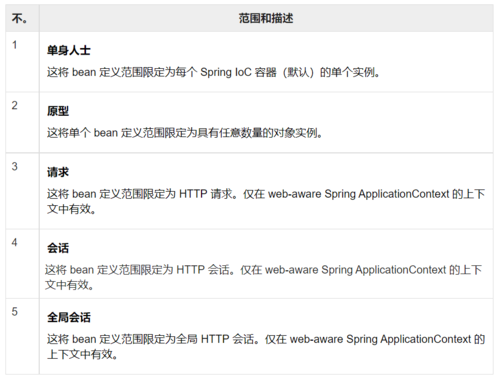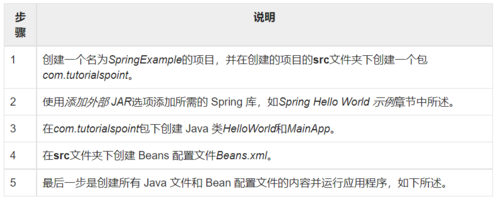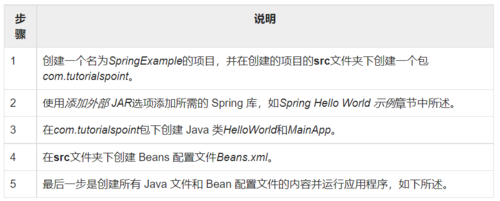定义 <bean> 时,您可以选择声明该 bean 的作用域。例如,要强制 Spring 在每次需要时生成一个新的 bean 实例,您应该将 bean 的 scope 属性声明为prototype。类似地,如果您希望 Spring 在每次需要时返回相同的 bean 实例,您应该将 bean 的 scope 属性声明为singleton。
Spring Framework 支持以下五个范围,其中三个仅在您使用 web-aware ApplicationContext 时可用。

在本章中,我们将讨论前两个范围,其余三个范围将在讨论 Web 感知 Spring ApplicationContext 时讨论。
单例范围
如果范围设置为单例,则 Spring IoC 容器将创建该 bean 定义定义的对象的一个实例。该单个实例存储在此类单例 bean 的缓存中,并且对该命名 bean 的所有后续请求和引用都返回缓存对象。
默认范围始终是单例。但是,当您只需要一个 bean 实例时,您可以在 bean 配置文件中将scope属性设置为singleton,如下面的代码片段所示 -
<!-- A bean definition with singleton scope --><bean id = "..." class = "..." scope = "singleton"> <!-- collaborators and configuration for this bean go here --></bean>
示例
让我们有一个工作的 Eclipse IDE 并采取以下步骤来创建一个 Spring 应用程序 -

这是HelloWorld.java文件的内容-
package com.tutorialspoint;public class HelloWorld {
private String message;
public void setMessage(String message){
this.message = message;
}
public void getMessage(){
System.out.println("Your Message : " + message);
}}以下是MainApp.java文件的内容-
package com.tutorialspoint;import org.springframework.context.ApplicationContext;import org.springframework.context.support.ClassPathXmlApplicationContext;public class MainApp {
public static void main(String[] args) {
ApplicationContext context = new ClassPathXmlApplicationContext("Beans.xml");
HelloWorld objA = (HelloWorld) context.getBean("helloWorld");
objA.setMessage("I'm object A");
objA.getMessage();
HelloWorld objB = (HelloWorld) context.getBean("helloWorld");
objB.getMessage();
}}以下是单例范围所需的配置文件Beans.xml -
<?xml version = "1.0" encoding = "UTF-8"?><beans xmlns = "http://www.springframework.org/schema/beans" xmlns:xsi = "http://www.w3.org/2001/XMLSchema-instance" xsi:schemaLocation = "http://www.springframework.org/schema/beans http://www.springframework.org/schema/beans/spring-beans-3.0.xsd"> <bean id = "helloWorld" class = "com.tutorialspoint.HelloWorld" scope = "singleton"> </bean></beans>
完成源文件和 bean 配置文件的创建后,让我们运行应用程序。如果您的应用程序一切正常,它将打印以下消息 -
Your Message : I'm object A Your Message : I'm object A
原型范围
如果范围设置为原型,则每次发出对该特定 bean 的请求时,Spring IoC 容器都会创建该对象的一个新 bean 实例。通常,对所有有状态 bean 使用原型作用域,对无状态 bean 使用单例作用域。
要定义原型范围,您可以在 bean 配置文件中将范围属性设置为原型,如以下代码片段所示 -
<!-- A bean definition with prototype scope --><bean id = "..." class = "..." scope = "prototype"> <!-- collaborators and configuration for this bean go here --></bean>
示例
让我们使用 Eclipse IDE 并按照以下步骤创建一个 Spring 应用程序 -

这是HelloWorld.java文件的内容
package com.tutorialspoint;public class HelloWorld {
private String message;
public void setMessage(String message){
this.message = message;
}
public void getMessage(){
System.out.println("Your Message : " + message);
}}以下是MainApp.java文件的内容-
package com.tutorialspoint;import org.springframework.context.ApplicationContext;import org.springframework.context.support.ClassPathXmlApplicationContext;public class MainApp {
public static void main(String[] args) {
ApplicationContext context = new ClassPathXmlApplicationContext("Beans.xml");
HelloWorld objA = (HelloWorld) context.getBean("helloWorld");
objA.setMessage("I'm object A");
objA.getMessage();
HelloWorld objB = (HelloWorld) context.getBean("helloWorld");
objB.getMessage();
}}以下是原型范围所需的配置文件Beans.xml -
<?xml version = "1.0" encoding = "UTF-8"?><beans xmlns = "http://www.springframework.org/schema/beans" xmlns:xsi = "http://www.w3.org/2001/XMLSchema-instance" xsi:schemaLocation = "http://www.springframework.org/schema/beans http://www.springframework.org/schema/beans/spring-beans-3.0.xsd"> <bean id = "helloWorld" class = "com.tutorialspoint.HelloWorld" scope = "prototype"> </bean></beans>
完成源文件和 bean 配置文件的创建后,让我们运行应用程序。如果您的应用程序一切正常,它将打印以下消息 -
Your Message : I'm object A Your Message : null

 随时随地看视频
随时随地看视频



